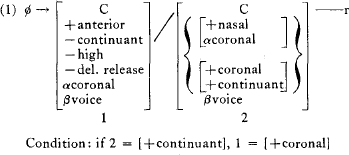Article contents
Old French Epenthesis and Syllabic Structure*
Published online by Cambridge University Press: 27 June 2016
Extract
In a provocative article in a recent issue of this journal, Walker (1978) accounts for Old French (OF) alternations of the type ancestre: ancessour, mendre: menour, prendre:prenons, and cosdre: cousons with a synchronic rule of consonant epenthesis given in (1) below:

The purpose of this remark is to argue that even if OF can be said to have consonant epenthesis as a synchronic phonological process (for some convincing arguments to the contrary, see Morin 1980 [above in this volume]), Walker’s formulation of it leaves a lot to be desired.
- Type
- Remarks/Remarques
- Information
- Canadian Journal of Linguistics/Revue canadienne de linguistique , Volume 25 , Issue 2 , Fall 1980 , pp. 226 - 230
- Copyright
- Copyright © Canadian Linguistic Association 1980
References
- 4
- Cited by


